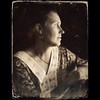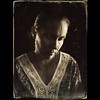
Essays
MAKARS OF BEAUTY
"Painting or art generally, as such, with all its technicalities, difficulties and particular ends, is nothing but a noble and expressive language."
~ John Ruskin Modern Painters
Makar is the Scots literary term given to a "maker" of poetry in the fifteenth and sixteenth centuries: the most revered of the Makars were Robert Henryson and William Dunbar. The term was revived in the twentieth century by the leading Scottish modernist writer, Hugh MacDiarmid to describe those of his fellow poets who chose to write in Scots rather than modern English. Whether medieval or modern what distinguishes the poetic language of the Makers is its emphatic sense of the opaque materiality of their verse. In such work the Makers' words, with their strong auditory impact and visual distinctiveness, are never treated as merely transparent semantic metaphors through which meaning passes like light passing through clear glass. On the contrary their approach to language was like that of a maker of things who skilfully works the material of his or her craft into a well made object of tangible beauty.
It could be argued that abstraction more than anything brought the ethos of the Makar back into the art of Western painting which had been lost since the end of the Middle Ages. It was the great Renaissance theorist Alberti who perceptively noted the transparency of post-mediaeval painting when he likened it to "a window on to the world"- but it has to be remembered that a window not only protects, but also separates. With emergence of the Modern world and the rise of Modernism, the medium- the material tactile stuff of paint -now began to reassert itself again as a crucially important collaborating agency of expression. As Clement Greenberg observed in his essay Modernist Painting of 1961, "Whereas one tends to see what is in an Old Master before seeing it as a picture, one sees a Modernist painting as a picture first." This undoubtedly is the case with most abstract painting as can immediately discerned by the works in this exhibition.
All the artists in Mark of Beauty are acutely aware- through their deeply serious attitude and considered approach to their work- of the complex and shifting relationship between paint as a physical entity, and painting as act of communication. At every stage in their demanding practice they are faced with the challenge- how does the painter negotiate between the dual demands of the medium and the message. This balancing act has to be achieved in such a way that something meaningful is created, but never at the expense of the visual means by which this is achieved. To examine this vitally important dialectic between plastic form and rhetorical content it is necessary to examine what is meant by the nature and use of language as it is expounded in the art of abstract painting.
All text, including painting, is multi-layered and there are at least four distinctive levels of visual language operating within pictorial communication. Firstly there is what might be termed the subliminal operation of language, which in the case of painting involves its basic building materials-space, shape, colour, line etc. The early abstractionists founded their faith on the particular ability of abstract art to release the authentic power of this innate language of profound significance and spiritual enlightenment. While the original mystical associations have now receded from abstraction many contemporary artists, especially those with a strong expressionist emphasis in their painting, create work that seeks "to plug" into this fundamental level of visual communication and make direct and visceral impact on the somatic and psychological sensibilities of the viewer.
Language at its secondary level of operation is where we discern different varieties of formalised semantic systems, such as English or Scots. In the visual arts we are also able to identify different languages of painting such as Impressionism and Cubism for example. Interestingly, at one time it was generally thought that abstraction transcended this level of language and it was hoped that it might become the universal Esperanto of artistic expression. That ideal however, has not proved to be the case, and abstraction is now generally regarded as specific artistic language operating at a secondary level of visual communication. As a consequence viewers need to be practiced and conversant in the language of abstraction, with its own particular pictorial conventions, to be able to respond appropriately to abstract paintings- in the same way as they need to know English in order to understand Shakespeare or Scots to appreciate Dunbar.
At the third level language is found to be much more particular in character than the earlier two. It is here that internal variety and differences within a mode of communication come into being as witnessed for instance by the innumerable variations on spoken English found all over the world. In modern art this can be seen for example in Cubism with the difference in means of formal expression between the analytical and synthetic language of cubist painting. Within the area of abstraction sub-languages of pictorial articulation have also evolved- "action" painting as opposed to geometrical hard edge for instance. In practice most painters are drawn towards their own particular choice of pictorial language through a number of factors- such as, personal temperament, artistic education, inspiring influences and the community of fellow practitioners with whom they keep company.
Finally, the fourth level of pictorial language is the most individual and specifically nuanced. It is here that the personal "voice", "handwriting" or "brushwork" of the author/creator is recognised and its unique characteristics are critically examined and aesthetically savoured. At this level the artist's own particular style and mode of expression comes to the fore, and it is this distinctive visual quality which allows us to have a much more appreciative and rewarding experience with a work of art. Being aware and sensitive to these different levels of visual language can allow us to experience a fuller range of experiences with a work of art- from an initial fairly open and instinctive reaction through to a much more focussed and intimate relationship in which the painting seems to "speak" directly to us at a deeply emotional and psychological level. When something like that does occur then the personal and the pictorial become as one and all four levels of language are in perfect unison with each other.
That being said, abstract art for many people can still be a difficult challenge - for it can sometimes seem rather overwhelming and a little disorientating until you have navigated your critical bearings and develop an approach that suits you best. Yet it is hoped that Mark of Beauty will in the end be an enjoyable and rewarding experience for the attentive and responsive viewer of this exhibition. The highly creative and accomplished work of the eight artists involved allows for a pertinent and comprehensive appreciation of the range and variety of contemporary abstract painting. The grouping of these abstract painters, who are at various stages- from early to mature- in their artistic development, reveals significant similarities and decided differences in their approach and practice. For instance the commonalities- such as the use decorative colour and gesture technique- to be found in all their work are mostly linked to the two primary levels of the pictorial language of painting as outlined above. On the other hand the recognisable marks of a distinctive style and unique personal vision in each of the individual artist's work- in the way they arrange compositional space and manipulate tactile pigment for instance- are the outcome of their sophisticated and highly skilful articulation of the super-structures of pictorial language.
As with the inherited visual language of painting which these artists draw upon, their own work is also multi-layered in its power of expression, and thus can be appreciated in a variety of different ways depending on what the viewer brings to each aesthetic encounter. Yet it has to be remembered however, that for all this talk of language, the visual experience of true painting- and this especially applies to abstraction- is not translatable into words; any more than poetry can be meaningfully turned into prose. Paintings, such as those in this exhibition, are not there as vehicles for semantic meaning or conceptual interpretation, but by their very physical being, are unmediated presences which contain their own significance within themselves through how they are physically made. Furthermore that significance must be unconditionally visual. Any truly meaningful experience has in the end to be an aesthetic revelation.
Bill Hare
Honorary Teaching Fellow in Scottish art history
at Edinburgh University



